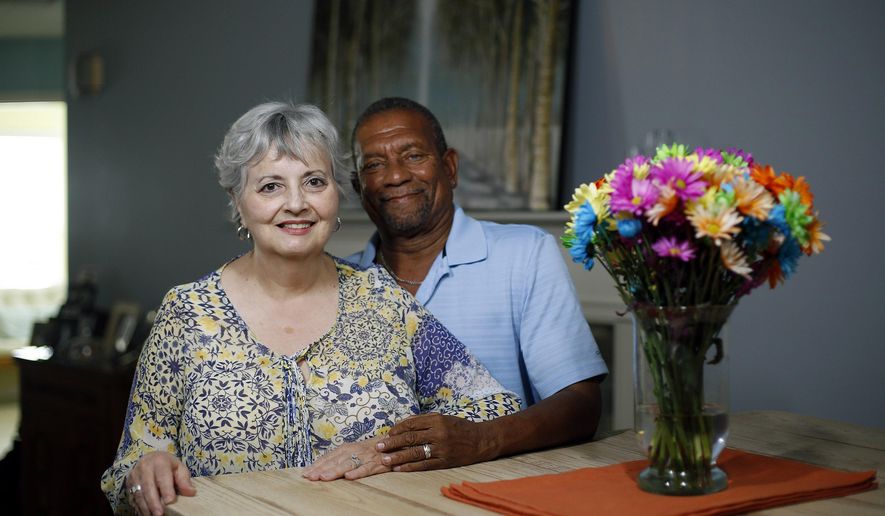COLUMBUS, Ohio (AP) - When Howard Foster broke up with Myra Clark more than 45 years ago, he did it because he feared she could never be happy if they stayed together.
But when he saw her again 43 years later, he knew he’d never let her get away again.
Decades after racism caused their breakup, the two reconnected at Sharon Woods Metro Park on a fall day in 2013, and they held hands across a picnic table as they talked like they’d never been apart.
“It was that dream you just never thought would come true … there she was,” Howard said.
Last week the interracial couple - Howard is black and Myra is white - sat together on the couch in their North Side home talking about their relationship. Each in their 60s, they hold hands each night when they fall asleep. Myra beams at Howard’s teasing and both say they don’t have any regrets about how things worked out.
The two were married in 2015.
This month marks 50 years since the Supreme Court case Loving v. Virginia made interracial marriage legal. The case was decided in 1967 after Mildred Jeter and Richard Loving, an interracial couple, sued Virginia, which had laws against marriages like theirs.
When the Fosters first dated in the late 1960s, racial tensions were thick in Columbus. Together, they attended Columbus West High School, where there were demonstrations related to race, the Ku Klux Klan recruited on the grounds and race-related gang violence wasn’t an unusual occurrence.
The couple persevered, often staying up into the early morning hours talking on the phone. But when they graduated in 1969, things changed, Howard said.
They continued their education, but Howard’s experience differed greatly from Myra’s. He faced racism from his professors and said he was the only black person at that time attending Columbus Technical Institute, now Columbus State Community College.
“It didn’t matter how well I did the project, it was always a D,” he said of one professor’s class. “I had never experienced that type of racism, that way. I said, ’It’s just not going to be good.’ I really thought about her.”
After that, Howard arranged to meet Myra in the Ohio State student union and ended their relationship. Myra didn’t say anything, but got up and walked away. At the opposite ends of the block, the two turned and looked back at each other and waved. Myra said she felt that meant they would see each other again someday.
“Society wasn’t going to let us be together and she be happy. … She’d get tired of the stares; I just thought it was unfair to her,” Howard said of his decision. “Her happiness was the most important thing.”
“I believed him. I believed he’d think I would be happy (without him), though he didn’t know what I’m made of,” Myra said. “And that’s okay.”
Since the Supreme Court decision, the number of interracial couples has grown. In 1967, only 3 percent of newlyweds in the country were married to someone of another race; by 2015, 17 percent were, according to a study by Pew Research. In Columbus, about 11 percent of newlyweds are interracial couples, according to the study.
The acceptance of interracial marriage has also increased since the Loving case. In 1958, only 4 percent of Americans favored marriage between blacks and whites, according to Gallup. In 2013, the number was up to 87 percent.
Claire Kamp Dush, associate professor in human sciences at Ohio State University, said interracial marriage is more acceptable now, in part because of the Civil Rights Movement.
There’s also the fact that many people don’t think it’s acceptable to be racist, and seeing more interracial couples “definitely helps,” Kamp Dush said.
Another factor might be that the nation is more racially and ethnically diverse than ever, especially in younger generations, said Kelly Stamper Balistreri, an assistant professor of sociology at Bowling Green State University. She’s working on a book called “Interracial Romance and Friendship in Adolescence and Adulthood” with two other college professors and expects interracial marriages to increase in the coming years.
Back in the Fosters’ home, the couple took turns giving their “side” of things as they laughed at the way the other described them.
“We enjoy each other; we really enjoy each other,” Howard said.
Though they each thought of the other over the years, neither seemed to think they would ever be together again, especially not married, Howard said.
Their paths might have crossed a million times as they each lived their lives in Columbus, though they’ll never know. In 2013, a mutual friend passed Myra’s contact information to Howard. She had heard the friend knew him and asked her to connect them.
When people asked the couple why they would get married in their 60s, Howard had a good answer: “We’re getting married not because we want to do anything, but just because we want to spend our lives together.
“Racism is in the minority,” Howard said, adding that when they found each other again, he wasn’t going to let anything keep them apart.
“I walked away once; I was not going to walk away again,” he said.




Please read our comment policy before commenting.